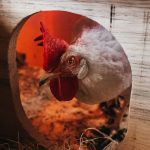Chickens are highly susceptible to heat stress, and it’s important for poultry farmers to understand the impact of heat on their birds. When temperatures rise, chickens can experience a range of negative effects, including decreased feed intake, reduced egg production, and even mortality. Heat stress can also lead to increased water consumption, which can further strain the birds’ systems.
Additionally, high temperatures can cause chickens to pant excessively in an effort to cool down, leading to respiratory distress and potential heat stroke. It’s crucial for poultry farmers to be aware of these potential impacts and take proactive measures to mitigate the effects of heat on their flocks. Furthermore, it’s important to recognize that different chicken breeds may have varying tolerances to heat.
For example, some breeds, such as the Leghorn, are more heat-tolerant than others. Understanding the specific needs of different breeds can help farmers tailor their management practices to ensure the well-being of their flocks during periods of extreme heat. By recognizing the impact of heat on chickens and considering breed-specific needs, poultry farmers can take proactive steps to protect their birds and minimize the negative effects of high temperatures.
Table of Contents
- 1 Providing adequate shade and shelter
- 2 Ensuring proper ventilation in the coop
- 3 Offering cool and refreshing treats
- 4 Providing access to fresh, cool water
- 5 Implementing a misting system or sprinklers
- 6 Monitoring and adjusting for extreme heat conditions
- 7 FAQs
- 7.1 What are the signs of heat stress in chickens?
- 7.2 How can I keep my chickens cool in hot weather?
- 7.3 What are some ways to provide shade for chickens?
- 7.4 How can I improve ventilation in the chicken coop?
- 7.5 What should I do if I notice a chicken showing signs of heat stress?
- 7.6 Are there specific breeds of chickens that are more heat-tolerant?
Key Takeaways
- Heat stress can have a significant impact on chickens, leading to decreased egg production, poor growth, and even death.
- Providing adequate shade and shelter is crucial to protect chickens from direct sunlight and high temperatures.
- Proper ventilation in the coop is essential to prevent heat buildup and maintain a comfortable environment for the chickens.
- Offering cool and refreshing treats, such as fruits and vegetables, can help chickens stay hydrated and cool during hot weather.
- Access to fresh, cool water is essential for chickens to stay hydrated and regulate their body temperature during hot weather.
- Implementing a misting system or sprinklers can help lower the temperature in the chicken coop and provide relief from extreme heat conditions.
- It is important to monitor and adjust for extreme heat conditions, such as providing additional shade or adjusting the misting system, to ensure the well-being of the chickens.
Providing adequate shade and shelter
Creating a Cooler Environment
One of the most important steps in protecting chickens from the negative effects of heat is to provide adequate shade and shelter. This can be achieved by ensuring that the chicken coop is well-ventilated and shaded from direct sunlight during the hottest parts of the day. Additionally, providing natural shade from trees or constructing shade structures can help create a cooler environment for the birds.
Optimizing Coop Orientation and Shade Placement
It’s important to consider the orientation of the coop and the placement of shade structures to ensure that the birds have access to relief from the heat throughout the day. In addition to providing shade, it’s important to ensure that the coop is well-insulated to prevent heat from building up inside.
Insulation and Cooling Strategies
This can be achieved by using reflective roofing materials and insulating the walls of the coop. By taking these measures, poultry farmers can create a comfortable and cool environment for their chickens, even during periods of extreme heat.
Minimizing the Negative Impacts of Heat
By providing adequate shade and shelter, poultry farmers can help their chickens stay cool and comfortable during periods of extreme heat, minimizing the negative impacts on their health and productivity.
Ensuring proper ventilation in the coop

Proper ventilation is essential for maintaining a comfortable and healthy environment for chickens, especially during hot weather. Good ventilation helps remove excess heat, moisture, and ammonia from the coop, creating a more comfortable living space for the birds. This can be achieved by installing vents and windows that allow for air circulation without creating drafts that could chill the birds.
It’s important to ensure that the coop has adequate ventilation throughout the day, including during the hottest parts of the day when temperatures are at their peak. In addition to natural ventilation, poultry farmers may also consider using fans to help circulate air within the coop. Fans can help reduce heat stress by increasing air movement and promoting evaporative cooling for the birds.
It’s important to regularly clean and maintain ventilation systems to ensure they are functioning properly and providing the necessary airflow for the birds. By ensuring proper ventilation in the coop, poultry farmers can help their chickens stay cool and comfortable during periods of extreme heat, reducing the risk of heat stress and its negative effects.
Offering cool and refreshing treats
During periods of extreme heat, it’s important to provide chickens with cool and refreshing treats to help them stay hydrated and cool down. This can include offering frozen fruits and vegetables, such as watermelon or cucumbers, which provide both hydration and a refreshing treat for the birds. Additionally, hanging frozen treats or ice blocks in the coop can provide a source of cool relief for the chickens as they peck at them throughout the day.
Providing these types of treats can help encourage chickens to stay hydrated and maintain their body temperature during hot weather. Furthermore, offering electrolyte supplements in the chickens’ water can help replenish essential nutrients lost through increased water consumption during periods of heat stress. Electrolytes can help support the birds’ overall health and well-being during times of high temperatures.
By offering cool and refreshing treats, poultry farmers can help their chickens stay hydrated and comfortable during extreme heat, reducing the risk of heat stress and its negative impacts on their health.
Providing access to fresh, cool water
Access to fresh, cool water is essential for chickens during periods of extreme heat. Poultry farmers should ensure that their birds have a constant supply of clean water that is kept at a cool temperature throughout the day. This can be achieved by using insulated waterers or adding ice to the water to help maintain its coolness.
It’s important to regularly check waterers to ensure they are functioning properly and not becoming too warm in the heat. In addition to providing cool water, it’s important to ensure that there are enough waterers available for all of the birds in the flock. This can help prevent competition for water and ensure that all chickens have access to hydration when they need it most.
By providing access to fresh, cool water, poultry farmers can help their chickens stay hydrated and maintain their body temperature during periods of extreme heat, reducing the risk of heat stress and its negative effects on their health.
Implementing a misting system or sprinklers

How Misting Systems Work
Misting systems release fine droplets of water into the air, which evaporate and lower the surrounding temperature. This creates a cooling effect, making the environment more comfortable for the birds during periods of extreme heat.
Using Sprinklers for Cooling
Similarly, sprinklers can be used to wet down outdoor areas where chickens spend time, providing a source of cool relief for the birds. However, it’s essential to use caution when implementing misting systems or sprinklers to avoid creating excessively wet or muddy conditions that could lead to other health issues for the birds.
Important Considerations
Additionally, it’s crucial to monitor humidity levels in the coop when using misting systems to ensure that they are not creating overly humid conditions that could contribute to respiratory issues for the chickens. By taking these precautions, poultry farmers can help their chickens stay cool and comfortable during periods of extreme heat, reducing the risk of heat stress and its negative impacts on their health.
Monitoring and adjusting for extreme heat conditions
During periods of extreme heat, it’s important for poultry farmers to closely monitor their flocks for signs of heat stress and make adjustments as needed to help their chickens stay cool and comfortable. This can include observing the birds for signs of panting, lethargy, or reduced activity, which may indicate that they are struggling with high temperatures. Additionally, monitoring water consumption and egg production can provide valuable insights into how the birds are coping with the heat.
Based on these observations, poultry farmers may need to make adjustments to their management practices, such as providing additional shade, offering more frequent access to cool water, or adjusting ventilation systems to improve airflow within the coop. It’s important to be proactive in responding to signs of heat stress in chickens to minimize its negative impacts on their health and productivity. By monitoring and adjusting for extreme heat conditions, poultry farmers can help their chickens stay healthy and comfortable during periods of high temperatures, ultimately supporting their overall well-being and performance.
If you’re looking for more information on keeping poultry, you might be interested in learning about how many eggs geese lay. Check out this article to find out more about geese and their egg-laying habits.
FAQs
What are the signs of heat stress in chickens?
Signs of heat stress in chickens include panting, holding their wings away from their bodies, decreased egg production, lethargy, and loss of appetite.
How can I keep my chickens cool in hot weather?
You can keep your chickens cool in hot weather by providing plenty of shade, ensuring good ventilation in the coop, offering cool water to drink, and providing frozen treats such as fruits and vegetables.
What are some ways to provide shade for chickens?
You can provide shade for chickens by using tarps, umbrellas, or natural shade from trees and shrubs. It’s important to make sure the shade is available throughout the day as the sun moves.
How can I improve ventilation in the chicken coop?
You can improve ventilation in the chicken coop by adding windows, vents, or fans to promote air circulation. This helps to reduce the build-up of heat and humidity inside the coop.
What should I do if I notice a chicken showing signs of heat stress?
If you notice a chicken showing signs of heat stress, move them to a cooler area with shade and provide them with cool water to drink. You can also use a misting system or wet towels to help lower their body temperature.
Are there specific breeds of chickens that are more heat-tolerant?
Yes, some breeds of chickens are more heat-tolerant than others. Breeds such as Leghorns, Rhode Island Reds, and Sussex are known for their ability to handle hot weather better than breeds with heavier feathers.
Meet Walter, the feathered-friend fanatic of Florida! Nestled in the sunshine state, Walter struts through life with his feathered companions, clucking his way to happiness. With a coop that’s fancier than a five-star hotel, he’s the Don Juan of the chicken world. When he’s not teaching his hens to do the cha-cha, you’ll find him in a heated debate with his prized rooster, Sir Clucks-a-Lot. Walter’s poultry passion is no yolk; he’s the sunny-side-up guy you never knew you needed in your flock of friends!







